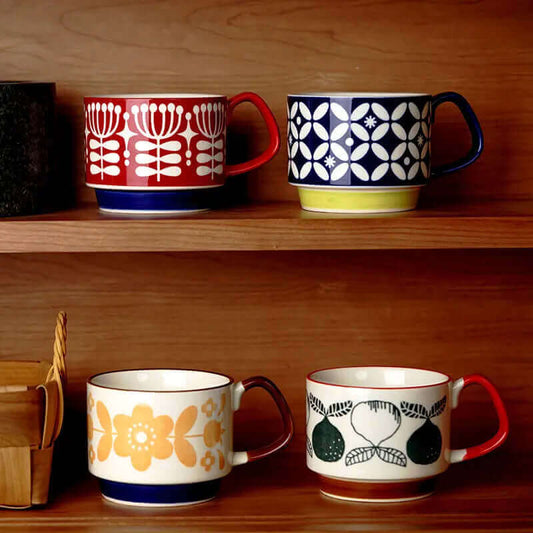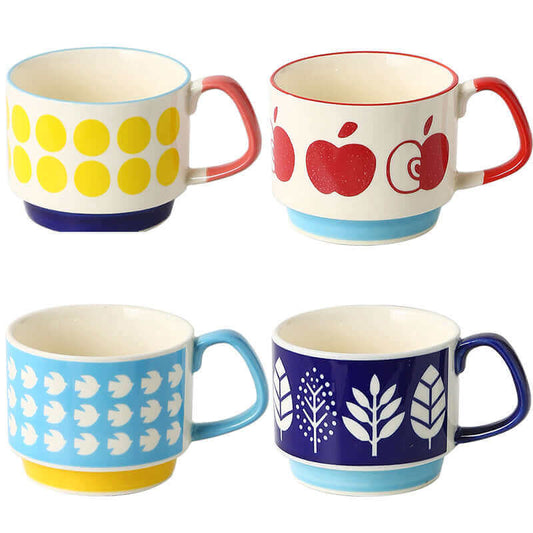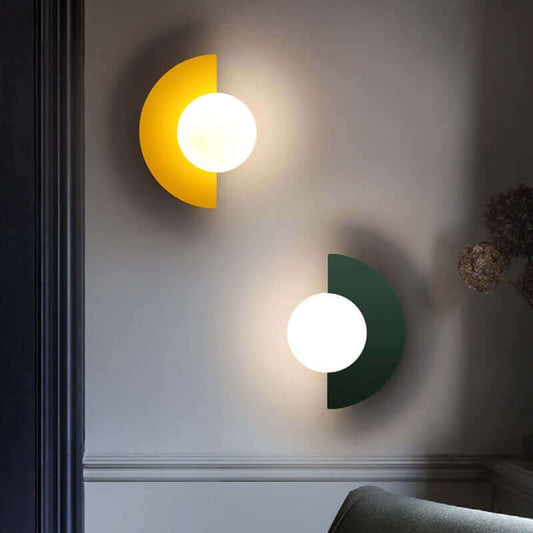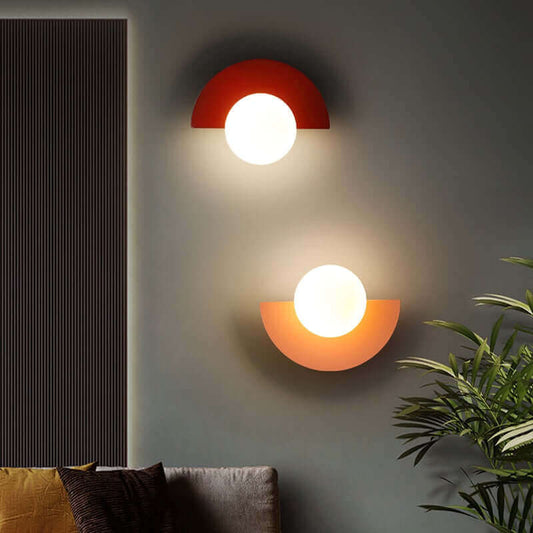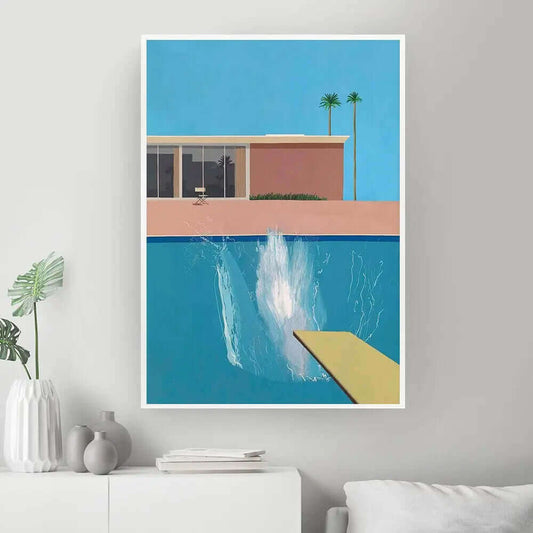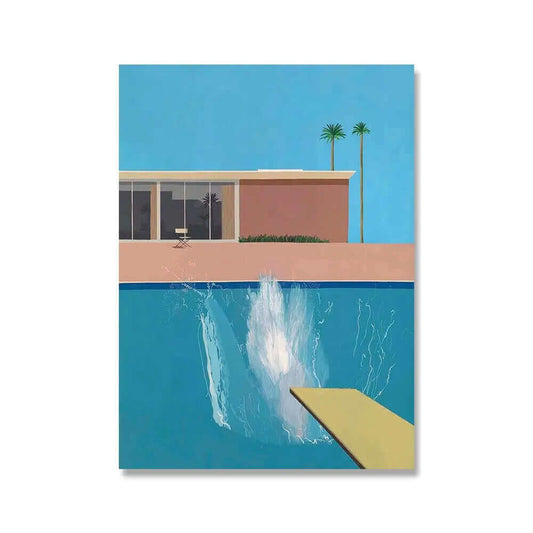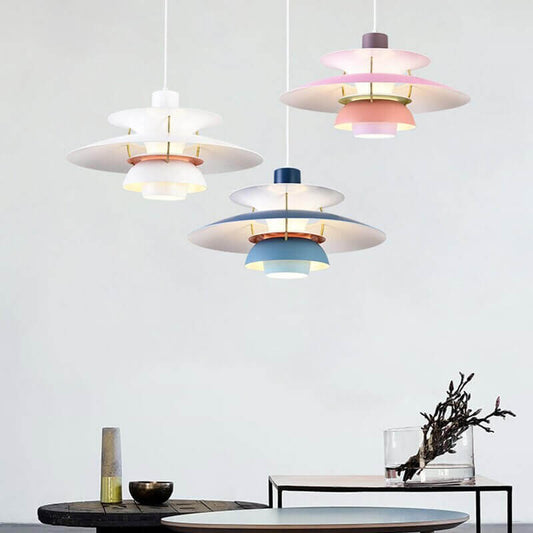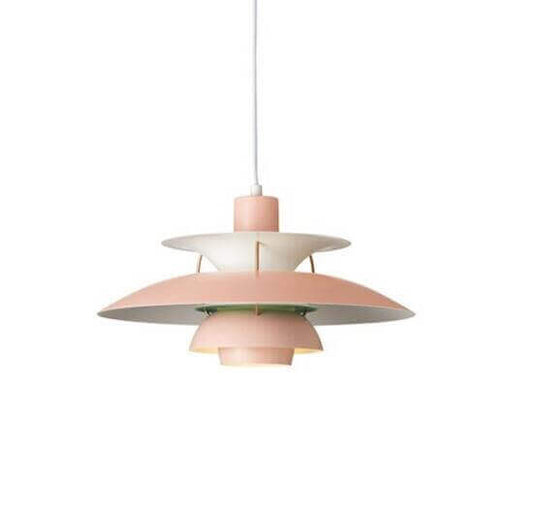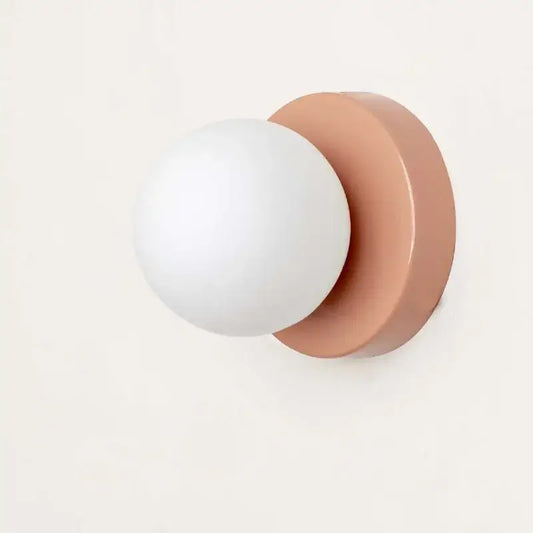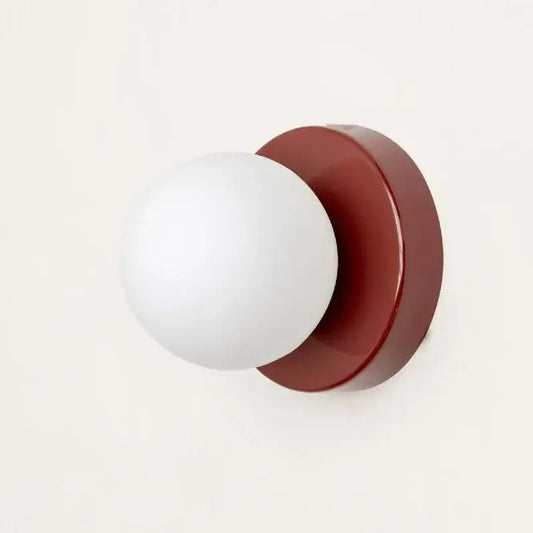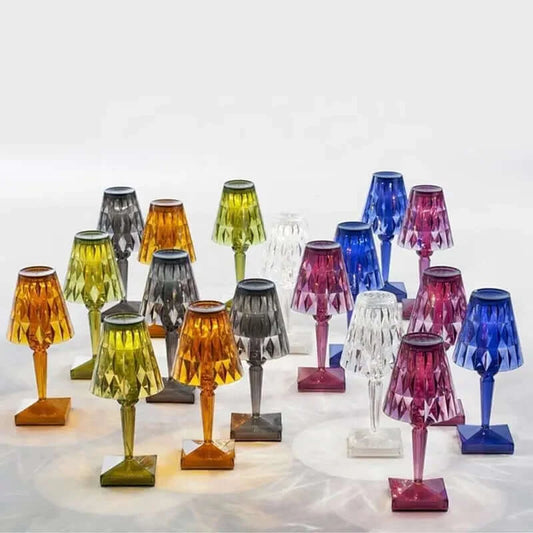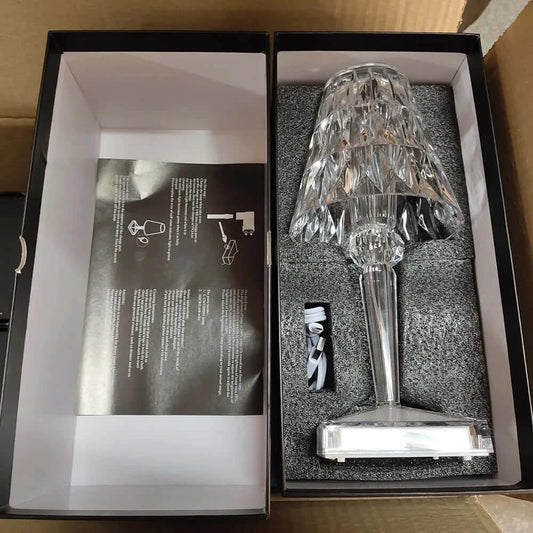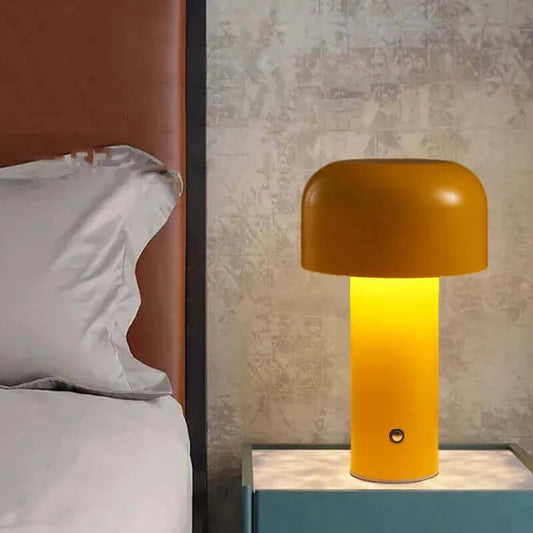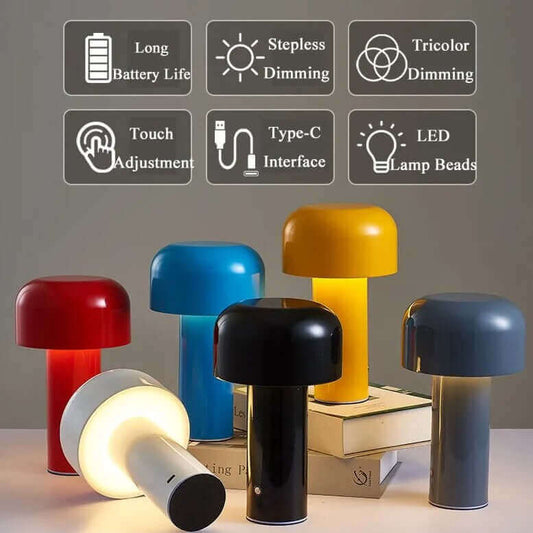Eames Lounge Chair
Definition: An iconic and timeless piece of furniture designed by Charles and Ray Eames in 1956. The Eames Lounge Chair is an epitome of mid-century modern design, featuring a molded plywood shell, premium leather upholstery, and a sleek metal base. Its innovative and ergonomic design has made it a classic and highly coveted furniture piece in mid-century modern interiors. The Eames Lounge Chair exudes comfort and sophistication, adding a touch of luxury and elegance to the space.
Noguchi Coffee Table
Definition: A coffee table designed by Isamu Noguchi in 1944, characterized by its organic and sculptural shape. The Noguchi Coffee Table is a prime example of mid-century modern design, with a glass top resting on two curved wooden supports. Its artistic and functional design has made it a popular and timeless addition to mid-century modern interiors. The Noguchi Coffee Table adds a sense of creativity and artistry to the space, becoming a focal point and conversation piece.
Atomic Age
Definition: A term used to describe the period from the late 1940s to the mid-1960s, characterized by the emergence of atomic energy and space exploration. The Atomic Age influenced mid-century modern design, inspiring futuristic and space-themed elements in interiors. Sputnik chandeliers, boomerang-shaped furniture, and atomic patterns are some of the design elements associated with the Atomic Age and mid-century modern style.
MCM Architecture
Definition: MCM stands for "Mid-Century Modern," and MCM Architecture refers to the architectural style prevalent during the mid-20th century, particularly from the 1940s to the 1960s. MCM Architecture emphasizes open floor plans, large windows, and a seamless connection between indoor and outdoor spaces. Flat roofs, clean lines, and geometric shapes are characteristic of MCM Architecture, contributing to the iconic and distinctive look of mid-century modern homes.
Mad Men
Definition: A popular television series set in the 1960s, known for its meticulous attention to mid-century modern design and style. "Mad Men" has played a significant role in popularizing and revitalizing interest in mid-century modern aesthetics, showcasing the sleek furniture, iconic decor, and retro ambiance of that era. The show's influence has contributed to the ongoing popularity of mid-century modern design in contemporary interior spaces.
Retro Futurism
Definition: An artistic and design movement that emerged in the mid-20th century, blending futuristic elements with a retro or vintage aesthetic. Retro Futurism influenced mid-century modern design, contributing to the incorporation of space-age and futuristic motifs in interior decor. Retro Futurism adds a sense of nostalgia and optimism to mid-century modern interiors, as it reflects the optimistic and forward-looking spirit of that era.
Teak
Definition: A tropical hardwood known for its durability, natural oils, and distinctive grain patterns. Teak wood was a favored material in mid-century modern furniture design due to its ability to withstand outdoor conditions and its warm, golden hue. Teak furniture pieces, such as tables, chairs, and cabinets, are common in mid-century modern interiors, adding a touch of organic and natural beauty to the space.
Sputnik Chandelier
Definition: A distinctive and futuristic chandelier design inspired by the Soviet satellite Sputnik, launched in 1957. Sputnik chandeliers are characterized by their symmetrical arms extending from a central sphere, adorned with multiple light bulbs. These chandeliers became a symbol of mid-century modern style, adding a bold and striking statement to the interior. Sputnik chandeliers are still popular in contemporary interior design, adding a touch of vintage charm and retro elegance to the space.
Atomic Patterns
Definition: Geometric patterns inspired by atomic and space-age motifs, commonly used in mid-century modern textiles, wallpaper, and decor. Atomic patterns often feature starbursts, boomerangs, and abstract shapes, reflecting the fascination with space exploration during the mid-20th century. These patterns add a playful and artistic touch to mid-century modern interiors, becoming a signature element of the design style.
Eames Molded Plastic Chair
Definition: A revolutionary chair design by Charles and Ray Eames, consisting of a molded plastic seat on a metal or wooden base. The Eames Molded Plastic Chair was introduced in 1948 and became an iconic and influential piece in mid-century modern design. The chair's innovative use of materials and ergonomic shape has made it a timeless and highly sought-after furniture piece in contemporary interiors.
Boomerang Shape
Definition: A design motif inspired by the curved and tapered shape of a boomerang, commonly used in mid-century modern furniture and decor. Boomerang shapes can be found in coffee tables, mirrors, and even patterns on textiles and wallpaper. This design element adds a sense of movement and dynamism to the space, becoming synonymous with mid-century modern style.
Arco Floor Lamp
Definition: A floor lamp designed by Achille and Pier Giacomo Castiglioni in 1962, featuring a large arc-shaped arm extending from a marble base. The Arco Floor Lamp is an iconic and functional piece in mid-century modern interiors, providing overhead lighting without the need for ceiling fixtures. Its timeless and elegant design has made it a classic addition to contemporary spaces, blending seamlessly with mid-century modern aesthetics.
Bauhaus
Definition: A design school founded in Germany in 1919 by architect Walter Gropius, with a strong influence on mid-century modern design. Bauhaus principles emphasized the integration of art, craft, and technology to create functional and aesthetically pleasing designs. The Bauhaus movement had a profound impact on mid-century modern design, contributing to the focus on simplicity, clean lines, and geometric forms in interior decor.
MCM Furniture
Definition: MCM stands for "Mid-Century Modern," and MCM Furniture refers to furniture pieces designed and manufactured during the mid-20th century, particularly from the 1940s to the 1960s. MCM Furniture is characterized by its sleek and minimalistic design, often featuring clean lines, organic forms, and innovative use of materials. Iconic MCM Furniture pieces, such as the Eames Lounge Chair and the Barcelona Chair, are highly sought-after collectibles in contemporary interior design.
George Nelson
Definition: An influential American designer and architect who played a significant role in shaping mid-century modern design. George Nelson's furniture designs, lighting fixtures, and home accessories are considered iconic and timeless examples of mid-century modern style. His work contributed to the development of the mid-century modern aesthetic, emphasizing functionality, simplicity, and innovative use of materials.
Panton Chair
Definition: A chair designed by Danish designer Verner Panton in the 1960s, known for its curvaceous and sculptural form. The Panton Chair was the first chair to be manufactured from a single piece of molded plastic, showcasing the innovative use of materials and production techniques. The chair's organic and futuristic design has made it a symbol of mid-century modern style, adding a sense of creativity and playfulness to interior spaces.
Tulip Table
Definition: A table design by Eero Saarinen, featuring a single pedestal base and a round or oval top. The Tulip Table is a classic and iconic piece in mid-century modern design, known for its minimalist and sculptural form. The table's sleek and elegant design has made it a popular choice for dining rooms and breakfast nooks in contemporary interiors, adding a touch of timeless and modern charm.
Herman Miller
Definition: An American furniture company founded in 1905, known for its significant contributions to mid-century modern design. Herman Miller collaborated with influential designers, such as Charles and Ray Eames, George Nelson, and Isamu Noguchi, to create iconic and innovative furniture pieces that became synonymous with mid-century modern style. Herman Miller's commitment to craftsmanship, quality, and progressive design continues to influence contemporary interior spaces.
Modular Shelving
Definition: A storage system consisting of interchangeable and stackable units, allowing for customizable and flexible arrangements. Modular shelving was a popular design concept in mid-century modern interiors, providing versatile and efficient storage solutions. These shelving systems can be configured to suit the specific needs and layout of the space, adding a practical and functional element to mid-century modern interiors.
Saarinen Table
Definition: A table designed by Finnish-American architect and designer Eero Saarinen, featuring a sculptural and curvaceous base with a round or oval top. The Saarinen Table is an iconic and timeless piece in mid-century modern design, known for its elegance and simplicity. The table's graceful and organic form has made it a popular choice for dining rooms and meeting spaces in contemporary interiors, adding a sense of sophistication and refinement.
Lucite
Definition: A transparent and lightweight material known as acrylic glass or polymethyl methacrylate (PMMA). Lucite was popular in mid-century modern design for its modern and futuristic appearance, often used in furniture, lighting fixtures, and home accessories. Lucite furniture and decor add a sense of transparency and lightness to the interior, creating a contemporary and airy look.
Mid-Mod
Definition: A shortened term for "Mid-Century Modern," often used to refer to design styles, furniture, and decor from the mid-20th century. Mid-Mod style emphasizes simplicity, clean lines, and functional design, capturing the essence of mid-century modern aesthetics. The term "Mid-Mod" is commonly used in contemporary interior design circles to describe the enduring popularity and influence of mid-century modern style.
Retro Revival
Definition: A resurgence of interest in retro and vintage aesthetics, particularly from the mid-20th century, including mid-century modern design. Retro Revival reflects the nostalgia for past eras and the appreciation for the timeless appeal of mid-century modern aesthetics. This design trend has led to a renewed interest in vintage furniture, decor, and color palettes, blending the charm of the past with contemporary living spaces.
Open Floor Plan
Definition: A design concept that eliminates interior walls and partitions, creating a single, open space that combines multiple functional areas, such as living room, dining room, and kitchen. Open floor plans were popularized during the mid-century modern era, emphasizing a sense of connectivity and fluidity in interior spaces. This design concept continues to be a sought-after feature in contemporary homes, allowing for a more social and versatile living environment.
Egg Chair
Definition: A chair design by Arne Jacobsen in 1958, known for its distinctive and cocoon-like shape. The Egg Chair is an iconic and sculptural piece in mid-century modern design, often upholstered in leather or fabric. Its curved and enveloping form creates a sense of privacy and comfort, making it a popular choice for lounge areas and reading nooks in contemporary interiors.
Minimalism
Definition: A design philosophy that emphasizes simplicity, restraint, and the elimination of unnecessary ornamentation. Minimalism was a significant influence on mid-century modern design, contributing to the clean lines, uncluttered spaces, and functional forms of the era. Minimalist interiors showcase the beauty of essential elements and the relationship between form and function, creating a sense of calm and balance in the space.
Milo Baughman
Definition: An American furniture designer known for his innovative and versatile designs during the mid-20th century. Milo Baughman's furniture pieces are characterized by their sleek and modern lines, often featuring metal frames and plush upholstery. His work played a significant role in shaping mid-century modern design, contributing to the timeless and sophisticated look of contemporary interiors.
Biomorphic Forms
Definition: Organic and fluid shapes inspired by natural forms, often seen in mid-century modern furniture and decor. Biomorphic forms reflect the fascination with nature and the influence of organic shapes on mid-century modern design. Furniture pieces with curved and flowing lines, such as amoeba-shaped coffee tables and kidney bean sofas, are examples of the use of biomorphic forms in mid-century modern interiors.
Boho
Definition: Short for "bohemian," Boho is a design style that blends various cultural influences, colors, and patterns to create a laid-back and eclectic look. Boho elements were sometimes incorporated into mid-century modern interiors, adding a sense of creativity and a mix of vintage and global aesthetics. Boho accents, such as colorful textiles, macrame wall hangings, and eclectic accessories, can add a bohemian touch to mid-century modern spaces.
Butterfly Roof
Definition: A roof design with two slopes that angle upward from the center, resembling the wings of a butterfly. The Butterfly Roof was popular in mid-century modern architecture, contributing to the distinctive and futuristic look of homes and buildings. This roof style allowed for clerestory windows and a sense of openness, maximizing natural light and connecting the interior with the outdoors.
Cherner Chair
Definition: A chair designed by Norman Cherner in the 1950s, featuring a molded plywood seat and backrest with a curvaceous and flowing form. The Cherner Chair is an iconic and sculptural piece in mid-century modern design, known for its timeless and elegant look. The chair's warm and natural materials add a touch of organic beauty to interior spaces, becoming a classic addition to contemporary design.
Color Blocking
Definition: A design technique that involves using large blocks of solid colors to create bold and graphic statements in interior decor. Color blocking was popular in mid-century modern interiors, contributing to the dynamic and vibrant look of the era. Color blocked walls, furniture, and decorative accessories add a playful and artistic touch to contemporary spaces, celebrating the power of color in interior design.
Danish Modern
Definition: A term used to describe furniture and design from Denmark during the mid-20th century, particularly the 1950s and 1960s. Danish Modern design is synonymous with mid-century modern style, emphasizing simplicity, functionality, and quality craftsmanship. Danish Modern furniture pieces, such as teak dining tables and leather sofas, are highly regarded for their timeless and elegant appeal.
Exposed Beams
Definition: Structural beams left visible in the interior design, often seen in mid-century modern homes with open floor plans. Exposed beams add a sense of rustic and industrial charm to the space, becoming an architectural and design feature. The natural texture and warmth of exposed beams contribute to the overall ambiance of mid-century modern interiors.
Florence Knoll
Definition: An influential American designer and architect known for her contributions to mid-century modern design. Florence Knoll's furniture designs are characterized by their clean lines, functionality, and attention to detail. Her work played a significant role in shaping the aesthetic and principles of mid-century modern interiors, focusing on minimalism and timeless elegance.
G-Plan
Definition: A British furniture brand founded in 1953, known for its stylish and affordable mid-century modern furniture designs. G-Plan furniture pieces were popular during the mid-20th century, offering a range of practical and fashionable pieces for contemporary interiors. G-Plan designs often feature teak wood, clean lines, and Scandinavian-inspired aesthetics.
Hans Wegner
Definition: A Danish furniture designer known for his iconic and innovative chair designs during the mid-20th century. Hans Wegner's furniture pieces are characterized by their organic and sculptural forms, often featuring solid wood construction and expert craftsmanship. His work played a significant role in defining the look of mid-century modern interiors, adding a touch of natural and timeless beauty to contemporary spaces.
Industrial Design
Definition: A design style inspired by the aesthetics of industrial spaces, machinery, and materials. Industrial Design influenced mid-century modern interiors, contributing to the use of metal, exposed pipes, and raw materials in furniture and decor. Industrial elements add a sense of urban and edgy charm to mid-century modern spaces, celebrating the beauty of industrial and utilitarian design.
Jens Risom
Definition: A Danish-American furniture designer known for his pioneering work in mid-century modern design. Jens Risom's furniture designs are characterized by their clean lines, practicality, and use of natural materials, such as maple and walnut. His work contributed to the popularity and lasting appeal of mid-century modern aesthetics, showcasing the marriage of function and style in interior design.
Knoll
Definition: A furniture company founded by Hans and Florence Knoll, known for its contributions to mid-century modern design. Knoll collaborated with influential designers, such as Eero Saarinen, Ludwig Mies van der Rohe, and Harry Bertoia, to create iconic and timeless furniture pieces. Knoll's commitment to innovative design and high-quality craftsmanship continues to influence contemporary interiors.
Lounge Chair
Definition: A comfortable and upholstered chair designed for relaxation and comfort, often with an accompanying ottoman. Lounge chairs were popular in mid-century modern interiors, offering a luxurious and inviting seating option. Iconic lounge chairs, such as the Eames Lounge Chair and the Barcelona Chair, are highly regarded for their sophisticated and timeless design.
Organic Architecture
Definition: An architectural philosophy that emphasizes harmony with the natural environment and the integration of design with its surroundings. Organic Architecture influenced mid-century modern homes, particularly those with an emphasis on indoor-outdoor living. These homes often feature large windows, open floor plans, and a seamless connection with nature, contributing to the sense of serenity and balance in the interior.
Ray and Charles Eames
Definition: A renowned husband-and-wife design team known for their significant contributions to mid-century modern design. Ray and Charles Eames collaborated on furniture design, architecture, and filmmaking, becoming pioneers of innovative and functional design. Their work, including the Eames Lounge Chair, molded plastic chairs, and plywood furniture, played a pivotal role in shaping the aesthetic of mid-century modern interiors.
Rietveld Chair
Definition: A chair designed by Dutch architect and designer Gerrit Rietveld in 1918, featuring a minimalist and geometric form. The Rietveld Chair is considered an early example of modernist design, inspiring later mid-century modern furniture. Its abstract and functional design has made it a significant and influential piece in the history of design and interior decor.
Scandinavian Influence
Definition: The impact of Scandinavian design on mid-century modern aesthetics, particularly during the mid-20th century. Scandinavian design principles, such as simplicity, functionality, and use of natural materials, heavily influenced mid-century modern interiors. The combination of Scandinavian and mid-century modern elements creates a harmonious and timeless look in contemporary design.
Space Age
Definition: A term used to describe the cultural and design enthusiasm surrounding space exploration during the mid-20th century. The Space Age influenced mid-century modern design, inspiring futuristic and space-themed elements in interiors. Space-age design featured fluid and aerodynamic forms, metallic finishes, and a sense of optimism for the future, contributing to the distinctive look of mid-century modern spaces.
Tulip Chair
Definition: A chair designed by Eero Saarinen, featuring a molded fiberglass or plastic shell atop a single pedestal base. The Tulip Chair is an iconic and sculptural piece in mid-century modern design, known for its elegant and streamlined form. The chair's sleek and futuristic design has made it a popular choice for dining rooms and living areas in contemporary interiors.
Vitra
Definition: A Swiss furniture company known for its commitment to innovative and timeless design. Vitra collaborated with influential designers, such as Charles and Ray Eames, George Nelson, and Verner Panton, to create iconic and collectible furniture pieces. Vitra's designs are associated with mid-century modern style and continue to be sought after by design enthusiasts worldwide.
Womb Chair
Definition: A chair designed by Eero Saarinen in 1948, known for its enveloping and cocoon-like shape. The Womb Chair is an iconic and comfortable piece in mid-century modern design, often upholstered in plush fabric or leather. Its organic and inviting form creates a sense of relaxation and serenity, making it a popular choice for lounging areas in contemporary interiors.
Whimsical
Definition: A design style characterized by playful and imaginative elements that evoke a sense of wonder and joy. Whimsical touches were occasionally incorporated into mid-century modern interiors, adding a lighthearted and creative vibe. Whimsical decor, such as quirky art, whimsical textiles, and eccentric accessories, can add a touch of whimsy to mid-century modern spaces.
Yellow Submarine
Definition: A song by The Beatles released in 1966 and a term used to describe the influence of pop culture and music on mid-century modern design. The Yellow Submarine aesthetic is characterized by bold colors, psychedelic patterns, and a sense of fun and nonconformity. Mid-century modern interiors sometimes incorporated elements of the Yellow Submarine style, adding a playful and groovy ambiance to the space.
Zigzag Chair
Definition: A chair designed by Gerrit Rietveld in 1934, featuring a geometric and abstract form. The Zigzag Chair is an avant-garde and iconic piece in modernist design, influencing later mid-century modern furniture. Its dynamic and playful design has made it a significant and admired piece in the history of design and interior decor.



